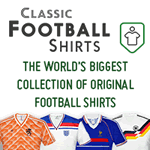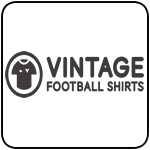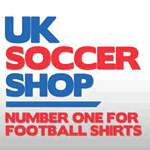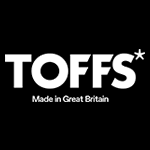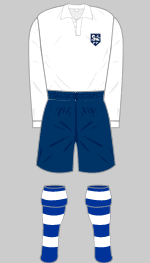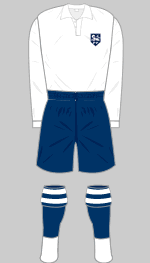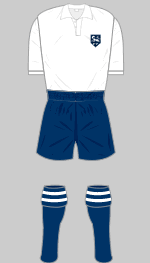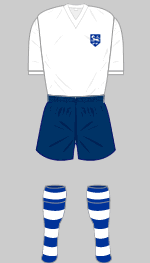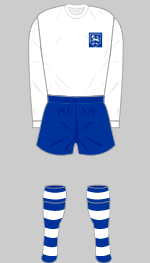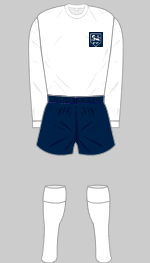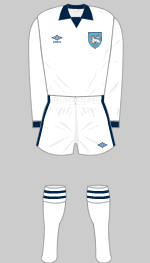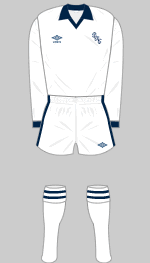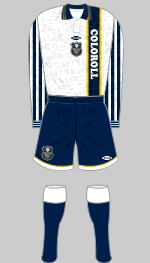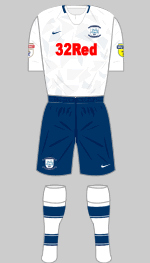Kit History

1880-1882 J

1882-1884 b v
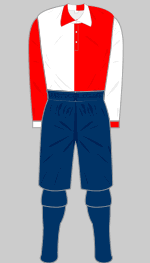
1884-1885 b B F
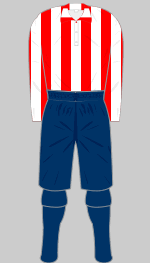
1885-1887 b c H
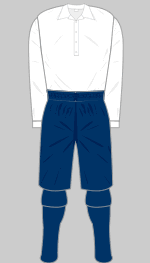
1887-1900 b c j l

1903-1904 B
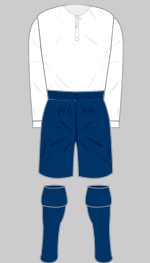
1904-1909 A D
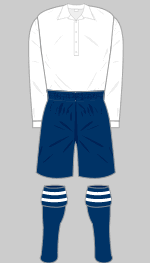
1909-1912 B
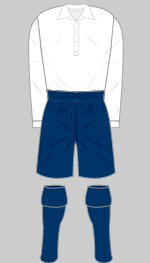
1912-1914 c v
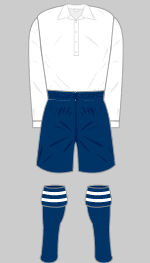
1914-1930 d B I

1931-1932 B
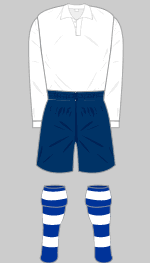
1948-1949 B

1956-1957 q x B

1973-1974 d o u

1974-1975 h o q y

1977-1978 c o q v

1978-1979 d o v x
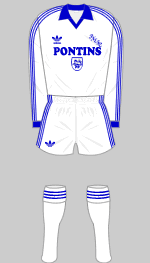
1979-1980 o q v
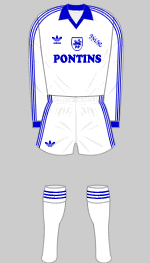
1980-1981 v
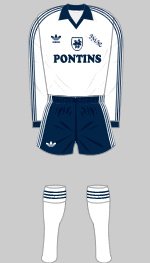
1981-1983 o

1983-1984 o q v

1984-1985 v
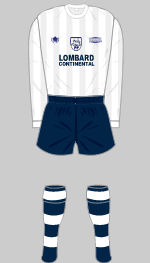
1985-1986 o q

1986-1988 c o p

1988-1989 o q v

1989-1990 o r s v
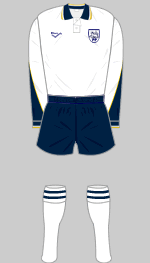
Aug-Sept 1990

Oct 1990-1992 o r v
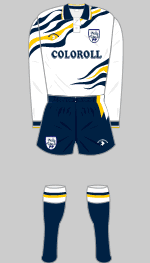
1992-1993 n s v

1993-1994 m
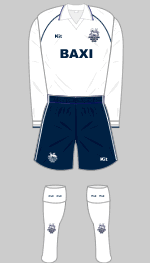
1998-2000 d s

2000-2002 d s

2002-2003 d

2003-2004 d
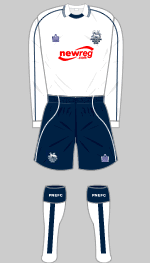
2004-2005 d

2005-2006 k
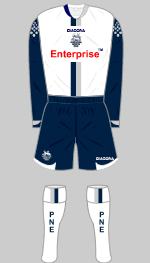
2006-2007 k v
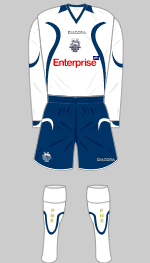
2007-2008 k t
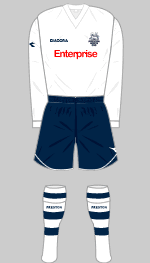
2008-2009 k
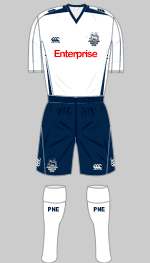
2009-2010 k
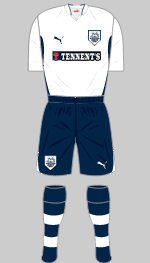
2010-2011 C
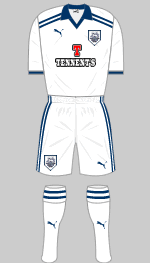
2011-2012 k
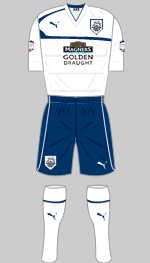
2012-2013 k
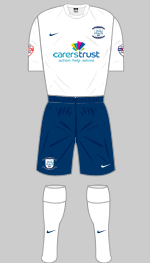
2013-2014 k
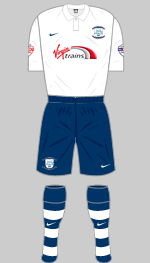
2014-2015 k
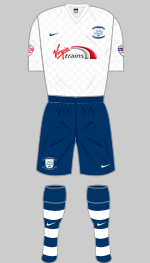
2015-2016 k
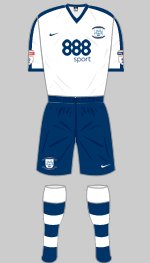
2016-2017 k
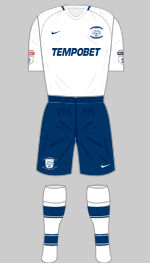
2017-2018 k
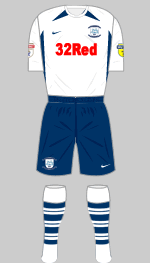
2019-2020 k
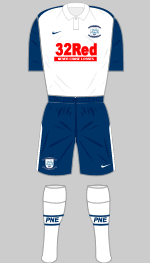
2020-2021 k
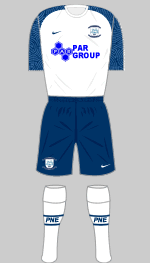
2021-2022 k
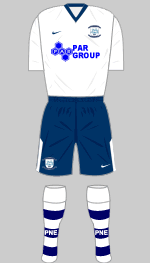
2022-2023 k
Background
 The club traces its origins back to 1863 when
cricket was regularly organised on “The Marsh,” a spit of
land in the Ribble estuary. When the Preston Corporation opened a new
public cricket ground at Moor Park in the northern part of the town, some
members moved to the new facility and adopted the name “North End.”
In 1875 the club took out a lease on a field at Deepdale, where the modern
club still plays.
The club traces its origins back to 1863 when
cricket was regularly organised on “The Marsh,” a spit of
land in the Ribble estuary. When the Preston Corporation opened a new
public cricket ground at Moor Park in the northern part of the town, some
members moved to the new facility and adopted the name “North End.”
In 1875 the club took out a lease on a field at Deepdale, where the modern
club still plays.
Around this time association football was becoming increasingly popular as a spectator sport in the industrial towns of Lancashire. Members first played football in 1878 and two years later they voted to adopt association rules in May 1880. In 1880-1881 the club played the Blackburn Rovers, one of the strongest teams in the country, three times and were trounced 0-16 in their third game played in March 1881.
Following the example of their Lancashire neighbours, Preston recruited players from Scotland (where the game was more advanced), offering financial inducements and employment to build a team that would become known as “The Invincibles.” In 1884 following an English Cup tie, Upton Park FC lodged a protest, alleging that some Preston players were paid. Club captain William Sudell did not deny this and although North End were expelled from the competition, the row led directly to the acceptance of professionalism.
Between August 1885 and April 1886 North End went 64 matches undefeated, winning 59 and scoring 318, conceding only 60. In 1887-88, they won 42 consecutive matches, established an English record that stands to this day by beating Hyde United 26-0 and reached the English Cup final.
Preston were invited to join the new Football League the following season. Now playing in plain white shirts and navy knickers, they achieved the first ever “double” by winning the championship without losing a match and won the English FA Cup without conceding a goal. The League championship was won again the following season and the club were runners up for the three seasons after that.
The club’s remarkable debut, which led to their nickname, “Proud Preston,” could not be sustained. In 1901 they were relegated although they returned as Division Two champions in 1904. In the four seasons before the First World War, North End were relegated, promoted, relegated and promoted yet again.
After the war, North End struggled to stay in the
First Division although they did reach the FA Cup final in 1922. Relegated
in 1925, they were back in Division One in 1934. They were Cup finalists
again in 1937 and 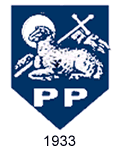 the following year, they won the competition for the
second time.
the following year, they won the competition for the
second time.
From 1933 the team wore the Preston coat of arms on their shirts. This consisted of the sacrificial lamb (representing the crucifixion of Jesus Christ) holding a flag of victory (representing the resurrection as victory over death) over the letters "PP," an abbreviation of Princeps Pacis (Latin for Prince of Peace). According to Dave Melling the media reinterpreted the initials as "Proud Preston" when the team met West Ham in the 1964 FA Cup final and this verion has since stuck.
A peculiarity of the period 1935 to 1957 was that the socks sometimes appeared to be a rather paler shade of dark blue than the navy knickers worn by the team. It also appears that the socks worn between 1951 and 1957 had cadet stripes on the tops and on the part of the sock normally concealed by the turnover. If the turnover was not perfectly folded the underlying bands would appear, giving the appearance of three or four narrow bands, while the 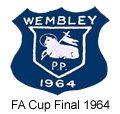 early examples (up until 1954) had a large white "foot" that could extend part way up the calf.
early examples (up until 1954) had a large white "foot" that could extend part way up the calf.
After the Second World War the legendary figure
of locally born Tom Finney dominated Deepdale but it was an era of near
misses. Preston were runners-up in the League in 1953 and 1958, and reached
the FA Cup Final in 1954. When Finney retired in 1960 the impact was immediate
and North End were relegated the following season. In 1964 they narrowly
missed out on promotion and reached the FA Cup final yet again but this
was to 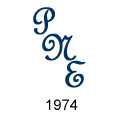 be the last swan song of a club that could no l
be the last swan song of a club that could no l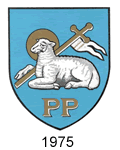 onger compete with
the rising big city sides.
onger compete with
the rising big city sides.
During the 1970s Preston played in both Second and Third Divisions wearing all-white strips. The famous crest was dropped in 1974 in favour of more fashionable script although for part of the 1975-76 season, the modern Preston arms were worn.
Between 1979 and 1986 both the traditional crest and monogramme 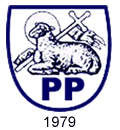 appeared on North End's shirts in various configurations. After 1983 the script used for the lettering was replaced by a modern font that appeared on the left breast while the crest was
appeared on North End's shirts in various configurations. After 1983 the script used for the lettering was replaced by a modern font that appeared on the left breast while the crest was  worn in the middle of the chest.
worn in the middle of the chest.
In 1985 the club dropped into Division Four and the following season, Proud Preston suffered the indignity of having to apply for re-election. In 1987 they were promoted but made no further progress and dropped down again in 1993.
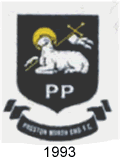 Several variations of the traditional crest appeared in the 90s. The 1993 version added a golden halo and the club's name appeared out
Several variations of the traditional crest appeared in the 90s. The 1993 version added a golden halo and the club's name appeared out 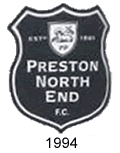 of a scroll. The following year the lamb and flag motif was reduced to a shield within a shield.
of a scroll. The following year the lamb and flag motif was reduced to a shield within a shield.
For the 1995-96 season a more enduring design appeared: the lamb and flag and the club's name now being given equal weight within a navy shield. This was modified slightly the following season when gold was added and the shape of the shield was simplified.
At the start of the 1998-99 season yet another version appeared: the design was now embroidered in navy blue 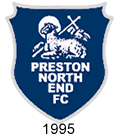 directly onto the shirt without a supporting shield. This incarnation proved a great deal more enduring than its predecessors and was worn virtually unaltered for the next ten years.
directly onto the shirt without a supporting shield. This incarnation proved a great deal more enduring than its predecessors and was worn virtually unaltered for the next ten years.
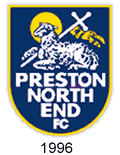 After 1996 Preston's fortunes
revived and they rose to Nationwide Division One (second tier) in 2000. They featured
twice in the play-offs and the prospects of returning to the top flight
no longer seemed as remote as they did in the mid 1980s.
After 1996 Preston's fortunes
revived and they rose to Nationwide Division One (second tier) in 2000. They featured
twice in the play-offs and the prospects of returning to the top flight
no longer seemed as remote as they did in the mid 1980s.
In 2009 work on improving Deepdale, begun in 1996, was completed providing an all-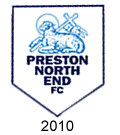 seated capacity of 23,400. Should the club's circumstances justify expansion, the roofs of three stands may be removed so additional tiers can be added to create up to 50,000 seats. Deepdale is also home of the National Football Museum and now the oldest stadium in the world to have been continuously used for football.
seated capacity of 23,400. Should the club's circumstances justify expansion, the roofs of three stands may be removed so additional tiers can be added to create up to 50,000 seats. Deepdale is also home of the National Football Museum and now the oldest stadium in the world to have been continuously used for football.
In 2010 the club adopted a slightly updated crest. The version shown here was worn by 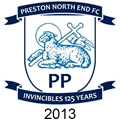 the team and is slightly different to the one that appeared on the club's web site, which had additional navy blue shadows behind the main shield.
the team and is slightly different to the one that appeared on the club's web site, which had additional navy blue shadows behind the main shield.
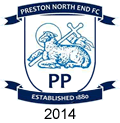 The 2013-14 season marked the 125th anniversary of the Football League's formation and of Preston winning the first ever championship undefeated. To mark the occasion, a special crest was commissioned that incorporated the traditional Proud Preston initials and their old nickname. The new badge evidently went down well and it reappeared the following season with the script "Established 1880" on the lower scroll.
The 2013-14 season marked the 125th anniversary of the Football League's formation and of Preston winning the first ever championship undefeated. To mark the occasion, a special crest was commissioned that incorporated the traditional Proud Preston initials and their old nickname. The new badge evidently went down well and it reappeared the following season with the script "Established 1880" on the lower scroll.
North End returned to the second tier via the play-offs in 2015.
Sources
- (a) Association of Football Statisticians
- (b) 'The History of PNEFC' (David Hunt) - information provided by Bill Beaver
- (c) Football Focus
- (d) empics
- (e) Workington AFC - Images of Sport (Paul Eade 2003)
- (f) Bristol Rovers FC - Images of Sport (Mike Jay)
- (g) Football Cards
- (h) Aldershot Has It
- (i) Bury FC - Images of Sport (Peter Cullen 1998)
- (j) Cleo.Net
- (k) Preston North End Official Website
- (l) British Library
- (m) Chairboys Website
- (n) Premier Shirts
- (o) Ralph Pomeroy
- (p) Jason Windsor
- (q) Petes Picture Palace
- (r) Bjørn-Terje Nilssen
- (s) David King
- (t) Football Shirt Culture
- (u) Football League Review
- (v) Paul Barnes
- (x) The Media Storehouse
- (y) Ray Jackson
- (z) Alec Hitchman
- (A) British Film Archive (Youtube)
- (B) Keith Ellis (HFK Research Associate)
- (C) George McDermott
- (D) Richard Essen
- (E) Simon Monks
- (F) Darren Foss
- (G) Media Storehouse submitted by John Smith.
- (H) Preston Herald (7 October 1885) submitted by Brian Webb.
- (I) Football & the First World War
- (J) Linda Martin
Modern crests are the property of Preston North End FC.
